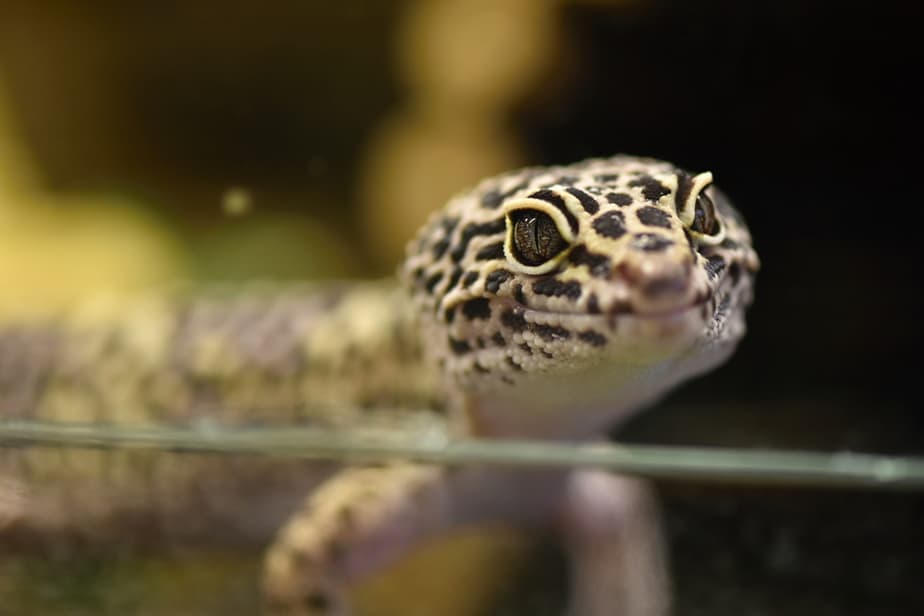We all know how annoying it is to grapple in the dark while we’re going to the loo or just trying to get a glass of water. It is inconvenient at best and terrifying at worst. So it makes sense to wonder if your leopard gecko needs a night light just as much as you. Well, this article is going to talk about just that.
So, do leopard geckos need light at night?
Leopard geckos don’t need light at night. They have excellent night vision and can move around just fine in the dark. Leaving a light on for your gecko all night can interfere with their sleep cycle. This is especially an issue if you’re using red or blue lights for a baby gecko.

Leopard Geckos and Night Lights
While it’s natural to want to watch your gecko at night, you shouldn’t leave their light on all night. Since they don’t get this type of light in their natural habitat, introducing it can disorient their sense of day and time.
This is particularly an issue because the onset of natural daylight is what signals to geckos that it’s time to sleep. On the other hand, its dissipation is what tells them it’s time to be active. As such, geckos start being active around dusk and continue doing so throughout the night before going to bed at around dawn.
It’s therefore important to provide your gecko with balanced intervals of light (day) and darkness (night).
Related: Can leopard geckos see in the dark?
Is It Okay to Rely on Natural Window Light for Your Leopard Gecko’s Daylight Needs?
In a bid to simulate the natural habitat of your leopard gecko, it is natural to consider using your natural window light. However, this comes with one major danger – your gecko’s tank could easily overheat.
This is likely to happen if the sun hits your window directly. The heat rays can quickly be transferred to your gecko’s terrarium and overheat their tank. Ultimately, this method of lighting is only safe when your windows aren’t hit directly by sun rays or are only hit by them for a short period.
But even in such cases, it can only be effective if the daylight cycles in the area you live closely match with those of your gecko’s natural habitat. Otherwise, you’re better off using secondary lighting options.
What Is The Ideal Lighting Setup For Leopard Geckos?
In case your natural window light can’t satisfy your leopard gecko’s lighting and heating needs, here are some options you can use:
- Daytime bulbs – these lights are also known as light and heat daylights because they emit both light and heat. When choosing these bulbs, go for those that don’t emit UV radiation and are between 100 and 150 watts. These are the best specifications for leopard geckos
- Ceramic heat bulbs – these are bulbs that emit heat but not light. Usually, they can increase the temperature of your gecko’s tank by up to 20 degrees Fahrenheit. Depending on the size of your gecko’s tank, you will need a wattage of between 100 and 150
- Heat mats – these are mats that you can stick to the bottom or sides of your gecko’s tank to emit heat. While they don’t get as hot as ceramic heat bulbs, they are lower wattage
Ultimately, an ideal lighting setup for a leopard gecko requires a combination of daytime bulbs and ceramic heat bulbs/heat mats. Alternatively, you could switch out the daytime bulbs for light-only ones. You will also need a timer and thermostat to monitor and control your setup.
This ensures that your leopard gecko gets the light and heat they need during the day and the heat they need during the night.
How Long Should You Leave The Bulbs and Heat Mats On?
When you have a leopard gecko, you’ll need to mimic the day and night patterns of the desert. This means that you’ll have to provide 14 hours of daytime light and 10 hours of nighttime (darkness) in the summer. However, during the winter you should only provide 12 hours of each.
To make things easier, ensure you use an automatic timer. This will keep you from having to plan your day around having to switch your gecko’s light’s on/off. It will also make the transition between the two seasons easier, especially since you’re going to have to do it gradually.
The best way to do this is to gradually increase/decrease the time at intervals of 15 to 30 minutes for a period of 4 to 8 weeks. Always remember that your leopard gecko should have a heat source 24/7 though.
Are Incandescent Bulbs Okay For Leopard Geckos?
Standard tungsten/halogen incandescent bulbs can be used as a source of both light and heat for your leopard gecko. Interestingly, there are now incandescent lights that are specialized for reptiles. They are more refined. Some even use neodymium glass to produce whiter, brighter light that resembles natural daylight.
Does Your Leopard Gecko Need UVB Rays?
While many people assume that their leopard geckos don’t need UVB rays, this isn’t true. Studies even show that exposure to UVB, even just for 2 hours a day can lead to higher vitamin D levels.
That’s why it’s becoming more and more popular for keepers of leopard geckos to use UVB lights for the daytime lighting of their tanks. These bulbs mimic the sun and help your gecko get vitamin D in the sun’s absence. However, just like the sun, your UVB light should not be shining at night.
Also, since these bulbs don’t emit heat, always remember to pair them with a heat source such as a ceramic bulb or heat mat.
Final thoughts
While your leopard gecko doesn’t need light at night, they do during the day. So, always ensure that your lighting setup is ideal and functional. This will do wonders for your gecko’s health and general wellbeing.
